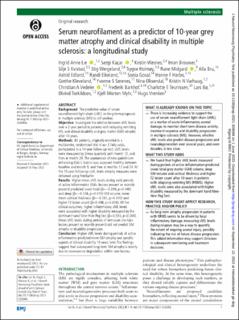| dc.contributor.author | Lie, Ingrid Anne | |
| dc.contributor.author | Kacar, Sezgi | |
| dc.contributor.author | Wesnes, Kristin | |
| dc.contributor.author | Brouwer, Iman | |
| dc.contributor.author | Kvistad, Silje S. | |
| dc.contributor.author | Wergeland, Stig | |
| dc.contributor.author | Holmøy, Trygve | |
| dc.contributor.author | Midgard, Rune | |
| dc.contributor.author | Bru, Alla Nikolajevna S | |
| dc.contributor.author | Edland, Astrid | |
| dc.contributor.author | Eikeland, Randi | |
| dc.contributor.author | Gosal, Sonia | |
| dc.contributor.author | Harbo, Hanne-Cathrin Flinstad | |
| dc.contributor.author | Kleveland, Grethe | |
| dc.contributor.author | Sørenes, Yvonne | |
| dc.contributor.author | Øksendal, Nina | |
| dc.contributor.author | Varhaug, Kristin Nielsen | |
| dc.contributor.author | Vedeler, Christian Alexander | |
| dc.contributor.author | Barkhof, Frederik | |
| dc.contributor.author | Teunissen, Charlotte E. | |
| dc.contributor.author | Bø, Lars | |
| dc.contributor.author | Torkildsen, Øivind Fredvik Grytten | |
| dc.contributor.author | Myhr, Kjell-Morten | |
| dc.contributor.author | Vrenken, Hugo | |
| dc.date.accessioned | 2023-01-24T15:32:14Z | |
| dc.date.available | 2023-01-24T15:32:14Z | |
| dc.date.created | 2022-08-11T15:58:13Z | |
| dc.date.issued | 2022 | |
| dc.identifier.citation | Journal of Neurology, Neurosurgery and Psychiatry. 2022, 93 (8), 1-9. | en_US |
| dc.identifier.issn | 0022-3050 | |
| dc.identifier.uri | https://hdl.handle.net/11250/3045990 | |
| dc.description.abstract | Background - The predictive value of serum neurofilament light chain (sNfL) on long-term prognosis in multiple sclerosis (MS) is still unclear.
Objective - Investigate the relation between sNfL levels over a 2-year period in patients with relapsing-remitting MS, and clinical disability and grey matter (GM) atrophy after 10 years.
Methods - 85 patients, originally enrolled in a multicentre, randomised trial of ω−3 fatty acids, participated in a 10-year follow-up visit. sNfL levels were measured by Simoa quarterly until month 12, and then at month 24. The appearance of new gadolinium-enhancing (Gd+) lesions was assessed monthly between baseline and month 9, and then at months 12 and 24. At the 10-year follow-up visit, brain atrophy measures were obtained using FreeSurfer.
Results - Higher mean sNfL levels during early periods of active inflammation (Gd+ lesions present or recently present) predicted lower total (β=−0.399, p=0.040) and deep (β=−0.556, p=0.010) GM volume, lower mean cortical thickness (β=−0.581, p=0.010) and higher T2 lesion count (β=0.498, p=0.018). Of the clinical outcomes, higher inflammatory sNfL levels were associated with higher disability measured by the dominant hand Nine-Hole Peg Test (β=0.593, p=0.004). Mean sNfL levels during periods of remission (no Gd+ lesions present or recently present) did not predict GM atrophy or disability progression.
Conclusion - Higher sNfL levels during periods of active inflammation predicted more GM atrophy and specific aspects of clinical disability 10 years later. The findings suggest that subsequent long-term GM atrophy is mainly due to neuroaxonal degradation within new lesions. | en_US |
| dc.language.iso | eng | en_US |
| dc.publisher | BMJ Publishing Group | en_US |
| dc.rights | Navngivelse 4.0 Internasjonal | * |
| dc.rights.uri | http://creativecommons.org/licenses/by/4.0/deed.no | * |
| dc.title | Serum neurofilament as a predictor of 10-year grey matter atrophy and clinical disability in multiple sclerosis: a longitudinal study | en_US |
| dc.type | Peer reviewed | en_US |
| dc.type | Journal article | en_US |
| dc.description.version | publishedVersion | en_US |
| dc.source.pagenumber | 1-9 | en_US |
| dc.source.volume | 93 | en_US |
| dc.source.journal | Journal of Neurology, Neurosurgery and Psychiatry | en_US |
| dc.source.issue | 8 | en_US |
| dc.identifier.doi | 10.1136/jnnp-2021-328568 | |
| dc.identifier.cristin | 2042528 | |
| cristin.ispublished | true | |
| cristin.fulltext | original | |
| cristin.qualitycode | 2 | |

